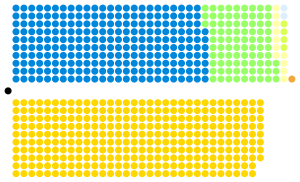The 1885 United Kingdom general election was held from 24 November to 18 December 1885. This was the first general election after an extension of the franchise and redistribution of seats. For the first time a majority of adult males could vote and most constituencies by law returned a single member to Parliament, fulfilling one of the ideals of Chartism to provide direct single-member, single-electorate accountability. (Fifty-four MPs were elected in two-member districts, using plurality block voting.)
| |||||||||||||||||||||||||||||||||||||||||||||||||
All 670 seats in the House of Commons 336 seats needed for a majority | |||||||||||||||||||||||||||||||||||||||||||||||||
|---|---|---|---|---|---|---|---|---|---|---|---|---|---|---|---|---|---|---|---|---|---|---|---|---|---|---|---|---|---|---|---|---|---|---|---|---|---|---|---|---|---|---|---|---|---|---|---|---|---|
| Turnout | 81.2% | ||||||||||||||||||||||||||||||||||||||||||||||||
| |||||||||||||||||||||||||||||||||||||||||||||||||
 Diagram displaying the composition of the House of Commons following the general election | |||||||||||||||||||||||||||||||||||||||||||||||||
| |||||||||||||||||||||||||||||||||||||||||||||||||
The election saw the Liberals, led by William Gladstone, win the most seats, but not an overall majority, so a minority government was necessary. The Irish Nationalists held the balance of power between the Liberals and the Conservatives who sat with a large number of allied Unionist MPs (their name referred to their support for the Union of Great Britain and Ireland). The pressure of minority government status exacerbated divisions within the Liberals over Irish Home Rule. This led to a Liberal split that caused another general election the following year.
The 1885 election saw the first socialist party participate, with the Social Democratic Federation led by H. M. Hyndman standing three candidates. None were elected.
Results
edit| UK General Election 1885 | |||||||||||||||
|---|---|---|---|---|---|---|---|---|---|---|---|---|---|---|---|
| Party | Candidates | Votes | |||||||||||||
| Stood | Elected | Gained | Unseated | Net | % of total | % | No. | Net % | |||||||
| Liberal | 575 | 319[a] | −33 | 47.61 | 47.65 | 2,071,868 | −7.3 | ||||||||
| Conservative | 597 | 247 | +10 | 36.87 | 43.00 | 1,869,560 | +0.9 | ||||||||
| Irish Parliamentary | 91 | 86 | +23 | 12.84 | 6.88 | 299,178 | +4.0 | ||||||||
| Independent Liberal | 35 | 11 | +11 | 1.64 | 1.28 | 55,652 | N/A | ||||||||
| Crofters | 6 | 4 | +4 | 0.60 | 0.38 | 16,551 | N/A | ||||||||
| Ind. Conservative | 8 | 2 | +2 | 0.30 | 0.29 | 12,599 | N/A | ||||||||
| Lib-Lab | 4 | 1 | +1 | 0.15 | 0.19 | 8,232 | N/A | ||||||||
| Independent | 6 | 0 | 0 | 0 | 0.15 | 6,570 | N/A | ||||||||
| Ind. Nationalist | 2 | 0 | 0 | 0 | 0.07 | 2,889 | N/A | ||||||||
| Scottish Land Restoration | 5 | 0 | 0 | 0 | 0.05 | 2,359 | N/A | ||||||||
| Irish Loyalist | 6 | 0 | 0 | 0 | 0.04 | 1,869 | N/A | ||||||||
| Social Democratic Federation | 3 | 0 | 0 | 0 | 0.02 | 657 | N/A | ||||||||
Voting summary
editSeats summary
editSee also
edit- List of MPs elected in the 1885 United Kingdom general election
- Parliamentary franchise in the United Kingdom 1885–1918
- Representation of the People Act 1884
- Redistribution of Seats Act 1885
- 1885 United Kingdom general election in Ireland
- 1885 United Kingdom general election in Scotland
- Hawarden Kite, Gladstone announces for Home Rule and wins over the Irish
Notes
edit- ^ a b The seat and vote count figures for the Liberals given here include the Speaker of the House of Commons, Arthur Peel
- ^ All parties shown.
References
edit- ^ "General Election Results 1885-1979". Archived from the original on 30 January 2012.
- Craig, F. W. S. (1989), British Electoral Facts: 1832–1987, Dartmouth: Gower, ISBN 0900178302
- Rallings, Colin; Thrasher, Michael, eds. (2000), British Electoral Facts 1832–1999, Ashgate Publishing Ltd




